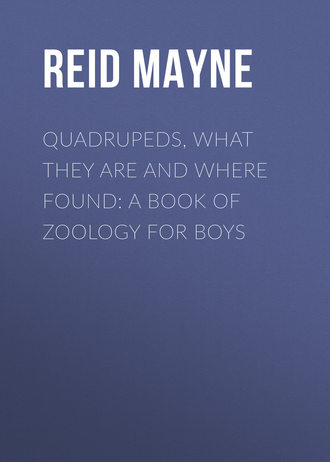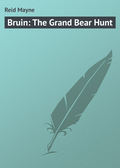
Майн Рид
Quadrupeds, What They Are and Where Found: A Book of Zoology for Boys
There is at least one other species of black bear indigenous to South America, inhabiting the tropical forests; but very little is known of it – further than that it is one of the smallest of the tribe.
We now reach the Asiatic bears, properly so called; and we have only space to say a word about each.
The Siberian bear is thought to be only a variety of the brown bear of Europe, differing slightly in colour. In the former there is a broad band, or collar, of white passing over the neck and meeting upon the breast. It is, as its name implies, an inhabitant of Siberia.
The Thibet bear is a dweller among the Himalayas – in Sylhet and Nepaul. Its general colour is black, with a white mark, shaped like the letter Y; so placed that the shank of the letter is upon its breast, and the forks running up the front of its shoulders. It is not carnivorous, and, generally, its disposition is harmless and playful. It is easily tamed.
The Sloth bear is another Indian species having this peculiar marking on the breast and shoulders. This animal is one of the oddest of creatures. Its short limbs and depressed head, with the long shaggy hair surmounting its back like a bullock, give it the appearance of being deformed. On this account it was the favourite of the Indian jugglers, who, depending on its ugliness as a source of attraction, trained it to a variety of tricks. It is therefore sometimes known as the jugglers’ bear (Ours jongleur). It has also a peculiar prehensile power in its lips; and this, with its general shaggy mien, led to the belief of its being a species of sloth – hence its common name.
The Malayan bear is another black species, with a marking on the breast. This mark is of a semi-lunar shape, and whitish; but the colour of the muzzle is buff-yellow. This is a very handsome species, subsisting on vegetable diet; and very injurious to the plantations of young cocoa trees, of the shoots of which it is very fond. It is also a honey eater; and roams about in quest of the hives of the indigenous bees. It is a native of Malacca, Sumatra, and others of the East Indian islands.
The Isabella bear is so called from its colour – being of that fulvous white known as Isabella colour. It is another of the species belonging to the great range of the Himalayas, and is found in the mountains of Nepaul. Sometimes it is observed of nearly a white colour; which led to the mistaken belief that Polar bears existed in the Himalayas.
The Syrian bear is a species found in the mountainous parts of Asia Minor. It is of a fulvous-brown colour, sometimes approaching to yellowish white. It is partly carnivorous, but feeds also on fruits; and is most remarkable as being the species first mentioned in books – that is, it is the bear of the Bible.
The Bornean bear is the last to be mentioned, though it is certainly one of the most beautiful, if not the most beautiful, of the genus. This beauty arises from its peculiar markings, especially from the large patch of rich orange colour upon the breast. It is a native of the great Island of Borneo, and little is known of its habits; but it is supposed to resemble the Malayan bear in these, as it does in many other respects.
In Africa there are no bears.
Chapter Four.
Badgers
The Badger is a silent, solitary, carnivorous creature, having his representative, in some form or other, in almost every part of the world; though nowhere either numerous in species or plentiful in individuals. In Europe he appears in two forms, the Glutton and common Badger; in North America in three, viz., Wolverene, American, and Mexican Badgers; and, indeed, we might say a fourth belongs to that continent, for the Racoon is as near being a badger, both in appearance and habits, as he is to being anything else. For convenience, therefore, let us class him in this group: he will certainly be more at home in it than among the bears– where most of the naturalists have placed him.
In South America we find another form of badger in the Coati mondi, of which there are several varieties; and there, too, the racoon appears of a species distinct from those of the north. Some writers class the coati with the civets, but the creature has far more of the habits and appearance of a badger than of a civet cat; and therefore, whatever the anatomists may say, we shall consider the coati a badger.
But a truer form of the badger than either of the above, exists in South America – extending over nearly the whole of that continent. This is the Grison, which, in appearance and habits, somewhat resembles the wolverene. It also is found in two or three varieties – according to the part of the country it inhabits. The Täira is another South American species of badger-like animal, though usually referred to the weasels.
In Africa, the badger appears in the Ratel, or honey badger, common from Senegal to the Cape. In Asia, in its northern zone, we have the European badger and Glutton; and in the south, the Indian badger; while in the Himalaya chain dwells another animal, closely allied to the badgers, called the Wha or Panda. In Java, we find still another species, the Nientek; and in the other large Asiatic islands there are several kinds of animals that approach very near to badgers in their forms and habits, but which are usually classed either with the weasels or civets.
We shall now give some details respecting the different animals of this family; among which the Glutton, in point of size, as well as for other reasons, deserves precedence.
The Glutton is the Rosomak of the Russians, in whose country he is chiefly found – along high northern latitudes, both in Europe and Asia. He is supposed to be identical with the wolverene of North America; and if this be so, his range extends all round the Arctic zone of the globe: since the wolverene is found throughout the whole extent of the Hudson’s Bay territory. There are good reasons to believe, however, that the two species differ considerably from each other – just as the European badger does from his American cousins. It was the writer Olaus Magnus who gave such celebrity to this animal, by telling a very great “story” about the creature – which, at a time when people were little studied in natural history, was readily believed. Olaus’s report was, that whenever the glutton killed an animal, he was in the habit of feeding on the carcass till his belly became swelled out and tight as a drum; that then he would pass between two trees growing close together – to press the swelling inwards and ease himself – after which he would return to the carcass, again fill himself, and then back again to the trees, and so on, till he had eaten every morsel of the dead animal, whatever might have been its size! All this, of course, was mere fable; but it is not without some foundation in fact: for the Rosomak is, in reality, one of the greatest gluttons among carnivorous animals. So, too, is his cousin, the wolverene of America; as the fur trappers have had sad reasons to know – whenever the creature has come upon a store of their provisions. The name of Glutton, therefore, though based upon Olaus Magnus’s exaggeration, is not so inappropriate.
The glutton and wolverene are, in fact, very like the common badger in their habits; except that being much larger and stronger animals, they prey upon larger game. The reindeer, and other large quadrupeds, are often the victims of both; and it is even said that they can overcome the great elk; but this is not confirmed by the observations of any trustworthy traveller. The young of the elk, or a disabled old one, may occasionally succumb to them, but not an elk in full vigour, nor yet a reindeer, except when they can surprise the latter asleep. Their game is usually the smaller quadrupeds; and in the fur countries no animal is a greater pest to the trapper than the wolverene or glutton. A single individual will in one night visit a whole line of traps, and rob them of the captured animals – whether they be polar hares, white or blue foxes, martens, or ermine weasels.
It is this creature that is usually represented lying in wait upon the limb of a tree, and springing upon deer as they pass underneath: but this story of its habits wants confirmation.
The fur of the wolverene is one of the staple articles of trade of the Hudson’s Bay Company; though it is more prized among the Russians than with us – who esteem it in value as next to the ermine.
The Common, or European badger, need not be here described, since it is familiar to all. The same may be said of the two American badgers, and also that of India, all three of which are very similar in habits and appearance to the common kind.
But the African badger, or Ratel, merits a word or two. It is about the size of the true badger, and ordinarily lives on small game, as badgers do; but, in addition to this, it is fond of varying its diet with a little honey. This it procures from the nests of wild bees, common throughout the whole of Africa. The account given of the mode in which it finds these nests would be incredible, were it not that we have the testimony of reverend missionaries to confirm it. It is as follows: – In Africa there is a bird – a species of cuckoo – known as the Indicator bird, or honey guide. This little creature hops from tree to tree, itself apparently in search of the bees’ nests. While doing so, it utters a shrill cry; and these cries are repeated until the honey hive is found. The ratel lies in wait for this bird; and, on hearing the cry, makes towards it, and keeps following its flights till the bees’ nest is found. Should this prove to be in a tree and out of reach – for the ratel is not a climber – the animal vents his chagrin by tearing at the trunk with his teeth, as if he had hopes of felling the tree. The scratches thus made on the bark serve as a guide to certain other creatures, who are also fond of honey, viz., the Kaffir hunters and Bushmen.
Should the bees’ nest prove to be on the ground, or under it, the ratel soon unearths the treasure with his strong claws, and takes possession of it, regardless of the stings of the bees, against which his thick skin defends him.
The Orison inhabits the forests of South America, from Guiana to Paraguay. It is quite as ferocious as any of the tribe; but its smaller size hinders it from attacking large animals, and its victims are birds, agoutis, and other small rodents – against all of which it wages a war of extermination. When surprised by the hunters and their dogs, it will battle furiously till life is extinct: all the while emitting a strong disagreeable smell, after the manner of the weasels and polecats. The Racoon, which we have grouped with the badgers, is both a North and South American animal; dwelling in dense forests, and making its lair in the hollow of a tree. This animal is a good tree-climber, and usually takes refuge among the higher branches when pursued. It is nocturnal in its habits, but in deep shady woods it may be seen prowling about in the daylight, in search of birds and their eggs, small rodents, fish, or frogs, all of which it eats indifferently. There are several distinct species.
The Coati is exclusively South American. This, unlike the racoon, sleeps at night, and prowls during the day. It is also an expert tree-climber, and has a peculiarity in this respect; viz., it descends a tree head foremost, which no other animal of its order can do. It is equally as fierce and carnivorous as any of the badgers; and its prey, as with the racoon, consists of birds, their eggs, and small quadrupeds. It feeds also upon insects; and will turn over the earth with its long proboscis-like snout. When drinking it laps like the dog. In eating, it uses its fore-paws to carry the food to its mouth, though not as squirrels and monkeys do. On the contrary, it first divides the flesh, or whatever it may be, into small morsels, and then raises these to its mouth by impaling them on its claws as on a fork!
It is not a solitary animal, but prefers the society of its companions, and usually goes about in troops or gangs. Its lair, like the racoon, is the hollow of a tree.
The Panda of the East Indies is an animal of very similar habits. It is found chiefly along the banks of streams that descend from the mountains; and subsists upon small quadrupeds and birds – which it is able to follow to the tops of the tallest trees. Its name of Qua, or Oua, or Wha, is derived from the cry which it utters, and repeats very often; and which is well represented by any of the syllables above written.
Chapter Five.
Weasels, Otters and Civets
Fortunate it is that the quadrupeds composing this group are all animals of small dimensions. Were they equal in size to lions and tigers, the human race would be in danger of total extirpation: for it is well-known that weasels are the most ferocious and bloodthirsty creatures upon the earth. None of them, however, much exceed the size of the ordinary cat: unless we include the gluttons and wolverenes among the weasels, as naturalists sometimes do, notwithstanding that these animals differ altogether from them.
The civets, it is true, are not usually classed with the weasels, but form a group of themselves; however, they are much more nearly related to weasels than the gluttons; and where, as in the present case, it is desirable to divide the mammalia into large groups, they will stand very well together. In truth, the civets are much nearer in resemblance to weasels than the otters are; and these two last are generally classed together – the otters being neither more nor less than water weasels.
We shall first consider the true Weasels: that is, the Weasels, Stoats, Ferrets, Polecats, and Martens.
The habits of most of the species are well-known; and all resemble each other in the exceeding ferocity of their disposition. It will only be necessary to say a word about their geographical distribution, and to speak of a few of the more noted kinds.
In Great Britain, five species are natives: the Pine and Beech Martens, the Stoat, the Common Weasel (which is the type of the family), and the Polecat. The Ferret is not indigenous to the country, but has been introduced from Africa, and is trained, as is well-known, for the pursuit of the rabbit – which it can follow into the very innermost recesses of its burrow. The English species of weasels are also common to other countries of Europe and Asia.
In the high northern latitudes of the Old World, we find a very celebrated species – celebrated for a long time on account of its valuable fur – the Sable. The sable is a true marten: a tree-climber, and one of the most sanguinary of weasels. An account of its habits, and of the mode of hunting it, forms one of the most interesting chapters in natural history.
An allied species inhabits the Hudson’s Bay territory, known as the American sable, and another, belonging to the Japanese islands, is called the Japan sable.
The Ermine is a species equally famous; and for a like reason – the value of its beautiful white fur, so long an article of commerce. The ermine is neither more nor less than a stoat in winter dress; but there are several varieties of it – some that turn to brown in summer, while another kind retains its snow-white covering throughout all the year. The ermine is common to Europe, Asia, and North America.
The Pekan is a larger species, belonging to North America, and semi-aquatic in its habits; while the Vison, or Mink, is a large black weasel that inhabits the borders of rivers in Canada and the United States, where it preys upon fish and aquatic reptiles.
In North America there is also a very large Pine marten, so called from its habit of dwelling in the pine forests – where it climbs the trees in pursuit of birds and squirrels. This is among the largest of the weasel tribe. In California, a new species has been described under the name of the Yellow-cheeked weasel, and in Mexico another, the Black – faced; so that North America has its full complement of these sanguinary quadrupeds. Nor is the southern division of that continent without its weasels, as there is one species or more in New Granada, one in Guiana, and two or three in Chili and Peru.
In India, there is the White-cheeked weasel, Hodgson’s and Horsefield’s weasels; and in Nepaul, the Nepaul weasel, and the Cathia. Further north in Asia, there is, in Siberia, the Vomela, the Chorok, and the Altai weasel of the Altai Mountains; and no doubt need exist that animals of the weasel tribe are to be found everywhere. Indeed, if we regard as weasels the various carnivorous quadrupeds of the glutton and badger family, which have been described elsewhere in these sketches – including the strange Teledu or Stinkard of Java, the Helietis of India and China, the Täira and Grison of Brazil, the Ratel or honey badger of Africa, the Zorille of the Cape, the Zorilla or Maikel of Patagonia, the Sand bear of India, and the numerous varieties of the celebrated Polecat, or Skunk, of North and South America – we may well say that there are weasels, or their representatives, in every hole and corner of the earth.
With regard to the Polecats of America, they form a sort of link between the weasels and civets; and although there was long supposed to be but one kind – as in the case of the opossum – it is now ascertained that there are several distinct species, with an endless list of varieties.
The Water Weasels, or Otters, are not so numerous either in species or individuals – though there are at least a dozen of them in all, and they are widely distributed over the world.
In Britain, there is but one – the Common or European otter; and in North America, a very similar species was supposed, until recently, to be the only one inhabiting that continent. The rivers of California, however, have presented us with a second, known as the Californian otter; and the singular Sea otter, whose beautiful fur is so prized under the name of Sea otter, is also an animal inhabiting the coasts of California – as it does most part of the western seaboard of the American continent.
The Grey otter is a South African animal, and in India we have the Wargul; while in the rivers of Nepaul – a country so rich in mammalia – there is the Golden brown otter. China, in common with other Indo-Chinese countries, possesses the Chinese otter; and South America has the Brazilian Contra, and in all probability several other species.
With regard to the Civet-Weasels– or Civet Cats, as they are commonly called – there is a still greater variety, both in genera and species: so many, indeed, that, as already stated, they have been arranged in a family by themselves. They may be regarded, however, as large weasels, distinguished from the others by their having a sort of pouch or gland under the tail, in which is secreted an unctuous and highly odorous substance. This, in some species, as in the true civets, is relished as a perfume or scent, while in others it is an extremely disagreeable odour. The true civet is a native of North Africa; where it is kept in a tame state, for the purpose of obtaining from it the well-known perfume of commerce. An allied species, the Rasse, belongs to Java – and is there also kept in cages for the same purpose – while in Asia – from Arabia to Malabar, and among the Malays and Arabs of Borneo, Macassar, and other islands of the Indian Archipelago – still another species of civet affords a similar perfumed substance.
The Aard Wolf (earth wolf) of South Africa is usually classed among the civets, but with very slight reason. It is far more like the hyena; and is certainly nothing else than a hyena.
The Delundung of Java is a creature that bears a resemblance to the civets; and may be regarded as forming a link between these and the true cats.
The Genets constitute a division of the civet-weasel tribe; and one of which there are numerous species. They are usually pretty spotted creatures, with immensely long tails; and but for their cruel and sanguinary habits would, no doubt, be favourites. They exist in South Europe; and, under different forms and appellations, extend over all Africa to Madagascar and the Cape – as well as through the countries of Southern Asia and the Asiatic islands.
The Ichneumons claim our attention next. These are celebrated animals, on account of the strange and fabulous tales related of the species known as the Egyptian ichneumon, which, among the people of Egypt, is domesticated, and was once held as a sacred animal. Besides the Egyptian ichneumon, there are several other species in Africa – one belonging to Abyssinia, and no less than six to the countries near the Cape. The Garangan of Java is an ichneumon; and so also are the Mongoos and Nyula of Nepaul; while in the Malay peninsula is a species known as the Malacca ichneumon. The Paradoxure is usually classed with the civets, though it wants the perfumed pouch; and the Suricate or Meer-cat, of the Cape colonists, takes its station in this group. A badger-like animal of Madagascar, the Mangu, is also regarded as a civet: so, too, are the Coatis of the New World, though these last are evidently of much nearer kin to the badgers.
Perhaps the curious creature known as the Potto, or Kinkajou, has more pretensions to a place among the civets: at all events, it deserves one in the general group of the weasels.







